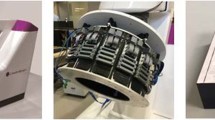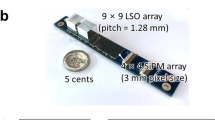Abstract
Objective
One trend in positron emission tomography (PET) instrumentation over the last decade has been the development of scanners dedicated to small animals such as rats and mice. Thicker crystals, which are necessary to obtain higher sensitivity, result in degraded spatial resolution in the peripheral field-of-view (FOV) owing to the parallax error. On the other hand, we are developing the jPET-D4, which is a dedicated human brain PET scanner that has a capability for depth-of-interaction (DOI) measurement. Although its crystal width is about twice that of commercially available small animal PET scanners, we expect the jPET-D4 to have a potential for small animal imaging by making full use of the DOI information. In this article, we investigate the jPET-D4’s potential for small animal imaging by comparing it with the microPET Focus220, a state-of-the-art PET scanner dedicated to small animals.
Methods
The jPET-D4 uses four-layered GSO crystals measuring 2.9 mm × 2.9 mm × 7.5 mm, whereas the microPET Focus220 uses a single layer of LSO crystals measuring 1.5 mm × 1.5 mm × 10.0 mm. First, the absolute sensitivity, counting rate performance and spatial resolution of both scanners were measured. Next a small hot-rod phantom was used to compare their imaging performance. Finally, a rat model with breast tumors was imaged using the jPET-D4.
Results
Thanks to the thicker crystals and the longer axial FOV, the jPET-D4 had more than four times higher sensitivity than the microPET Focus220. The noise equivalent counting-rate performance of the jPETD4 reached 1,024 kcps for a rat-size phantom, whereas that of the microPET Focus220 reached only 165 kcps. At the center of the FOV, the resolution was 1.7 mm for the microPET Focus220, whereas it was 3.2 mm for the jPET-D4. On the other hand, the difference of resolution became smaller at the off-center position because the radial resolution degraded faster for the microPET Focus220. The results of phantom imaging showed that the jPET-D4 was comparable to the microPET Focus220 at the off-center position even as the microPET Focus220 outperformed the jPET-D4 except for the peripheral FOV.
Conclusions
The jPET-D4 human brain PET scanner, which was designed to achieve not only high resolution but also high sensitivity by measuring DOI information, was proven to have a potential for small animal imaging.
Similar content being viewed by others
References
Cherry SR, Gambhir SS. Impact of noninvasive technology on animal research. Inst Lab Animal Res J 2001;42:219–232.
Cherry SR. In vivo molecular and genomic imaging: new challenges for imaging physics. Phys Med Biol 2004;49:R13–R48.
Jagoda EM, Vaquero JJ, Seidel J, Green MV, Eckelman WC. Experiment assessment of mass effects in the rat: implications for small animal PET imaging. Nucl Med Biol 2004;31:771–779.
Hume SP, Myers R. Dedicated small animal scanners: a new tool for drug development? Curr Pharm Des 2002;8:1497–1511.
Funk T, Sun M, Hasegawa BH. Radiation dose estimate in small animal SPECT and PET. Med Phys 2004;31:2680–2687.
Stickel JR, Cherry SR. High-resolution PET detector design: modeling components of intrinsic spatial resolution. Phys Med Biol 2005;50:179–195.
Watanabe M, Okada H, Shimizu K, Omura T, Yoshikawa E, Kosugi T, et al. A high resolution animal PET scanner using compact PS-PMT detectors. IEEE Trans Nucl Sci 1997;44:1277–1282.
Cherry SR, Shao Y, Silverman RW, Meadors K, Siegel S, Chatziioannou A, et al. MicroPET: a high resolution PET scanner for imaging small animals. IEEE Trans Nucl Sci 1997;44:1161–1166.
Del Guerra A, Di Domenico G, Scandola M, Zavattini G. YAP-PET: first results of a small animal positron emission tomograph based on YAP:Ce finger crystals. IEEE Trans Nucl Sci 1998;45:3105–3108.
Tai YC, Chatziioannou A, Siegel S, Young J, Newport D, Goble RN, et al. Performance evaluation of the microPET P4: a PET system dedicated to animal imaging. Phys Med Biol 2001;46:1845–1862.
Matsumura A, Mizokawa S, Tanaka M, Wada Y, Nozaki S, Nakamura F, et al. Assessment of microPET performance in analyzing the rat brain under different types of anesthesia: comparison between quantitative data obtained with microPET and ex vivo autoradiography. NeuroImage 2003;20:2040–2050.
Knoess C, Siegel S, Smith A, Newport D, Richerzhagen N, Winkeler A, et al. Performance evaluation of the microPET R4 PET scanner for rodents. Eur J Nucl Med Mol Imaging 2003;30:737–747.
Surti S, Karp JS, Perkins AE, Freifelder R, Muehllehner G. Design evaluation of A-PET: a high sensitivity animal PET camera. IEEE Trans Nucl Sci 2003;50:1357–1363.
Fontaine R, Bélanger F, Viscogliosi N, Semmaoui H, Tétrault M-A, Michaud J-B, et al. The architecture of LabPET. A small animal APD-based digital PET scanner. Nuclear science symposium and medical imaging conference record 2005. New York: IEEE 2005, p. J02–3.
Laforest R, Siegel S, Newport DF, Yap J. Performance evaluation of the microPET-Focus-F120. Nuclear science symposium and medical imaging conference record 2005. New York: IEEE 2004, p. M05–118.
Tai YC, Ruangma A, Rowland D, Siegel S, Newport DF, Chow PL, et al. Performance evaluation of the microPET Focus: a third-generation microPET scanner dedicated to animal imaging. J Nucl Med 2005;46:455–463.
Nishikido F, Tsuda T, Yoshida E, Inadama N, Shibuya K, Yamaya T, et al. Spatial resolution evaluation with a pair of two four-layer DOI detectors for small animal PET scanner: jPET-RD. Nucl Instrum Methods Phys Res A 2008;584:212–218.
Wienhard K, Schmand M, Casey ME, Baker K, Bao J, Eriksson L, et al. The ECAT HRRT: performance and first clinical application of the new high-resolution research tomograph. IEEE Trans Nucl Sci 2002;49:104–110.
Seidel J, Vaquero JJ, Green MV. Resolution uniformity and sensitivity of the NIH ATLAS small animal PET scanner: comparison to simulated LSO scanners without depth-of-interaction capability. IEEE Trans Nucl Sci 2003;50:1347–1350.
Ziemons K, Auffray E, Barbier R, Brandenburg G, Bruyndonckx P, Choi Y, et al. The ClearPET project: development of a 2nd generation high-performance small animal PET scanner. Nucl Instrum Methods Phys Res A 2005;537:307–311.
Yamamoto S, Mashino H, Kudo H, Matsumoto K, Senda M. A dual layer GSO PET system for small animal: K-PET II. IFMBE Proc 2006;14:1712–1715.
Ohi J, Tonami H. Investigation of a whole-body DOI-PET system. Nucl Instrum Methods Phys Res A 2007;571:223–226.
Yamada R, Watanabe M, Omura T, Sato N, Shimizu K, Takahashi M, et al. Development of a small animal PET scanner using DOI detectors. IEEE Trans Nucl Sci 2008;55:906–911.
Murayama H, Ishibashi H, Uchida H, Omura T, Yamashita Y. Depth encoding multicrystal detectors for PET. IEEE Trans Nucl Sci 1998;45:1152–1157.
Inadama N, Murayama H, Omura T, Yamashita T, Yamamoto S, Ishibashi H, et al. A depth of interaction detector for PET with GSO crystals doped with different amounts of Ce. IEEE Trans Nucl Sci 2002;49:629–633.
Yamaya T, Yoshida E, Lam CF, Konami A, Obi T, Murayama H. Implementation of 3D image reconstruction with a precomputed system matrix for the jPET-D4. Conference record of 9th international meeting on fully three-dimensional image reconstruction in radiology and nuclear medicine; 2007. p. 92–95.
Yoshida E, Kobayashi A, Yamaya T, Watanabe M, Nishikido F, Kitamura K, et al. The jPET-D4: performance evaluation of four-layer DOI-PET scanner using the NEMA NU2-2001 standard. Nuclear science symposium and medical imaging conference record. New York: IEEE; 2006. p. M11–146.
Yamaya T, Hagiwara N, Obi T, Yamaguchi M, Kita K, Ohyama N, et al. DOI-PET image reconstruction with accurate system modeling that reduces redundancy of the imaging system. IEEE Trans Nucl Sci 2003;50:1404–1409.
Knoess C, Lenox M, Goble RN, Siegel S, Smith AM, Vollmar S, et al. Comparative study of ECAT HRRT and microPET R4 for animal PET studies. Nuclear science symposium and medical imaging conference record. New York: IEEE; 2002. p. M03–171.
Author information
Authors and Affiliations
Corresponding author
Rights and permissions
About this article
Cite this article
Yamaya, T., Yoshida, E., Toramatsu, C. et al. Preliminary study on potential of the jPET-D4 human brain scanner for small animal imaging. Ann Nucl Med 23, 183–190 (2009). https://doi.org/10.1007/s12149-008-0224-2
Received:
Accepted:
Published:
Issue Date:
DOI: https://doi.org/10.1007/s12149-008-0224-2




